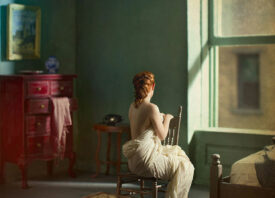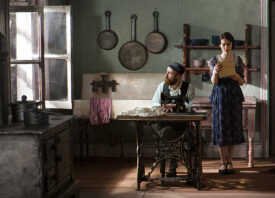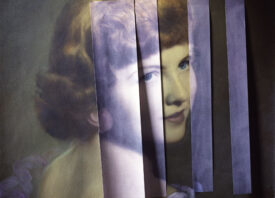Search this site
A Photographer Recreates His Childhood In Vivid Detail


“I remember playing my toy guitar along with 45 rpm records in our living room from about the age of four,” the photographer Richard Tuschman tells me. “My father was in the radio business, and my parents had stacks of 45 rpm records, the Everly Brothers being my favorite at the time, and a little later, Chubby Checker. Eventually, after much pleading, my parents signed me up for guitar lessons when I was about nine.”
For his most recent body of work, My Childhood Reassembled, Tuschman painstakingly recreated the house where he and his family lived, beginning in 1958 when the artist was two years old, in miniature. From there, he cast and photographed models to represent himself and his family members, later inserting them digitally into the tiny set (his signature process).
The house, which he describes as an “unremarkable, utilitarian two-family, red brick cube” was located in the suburb of Shaker Heights, Ohio, described by Cosmopolitan in 1963 as “an American dream town come true.” The family remained at that house for eight years, moving when Tuschman was ten years old.
It took him half that time to build the miniature model half a century later, with construction on the project beginning in 2016. “In order for the images to feel emotionally authentic, I wanted to duplicate, in miniature, every possible detail as closely as possible,” he remembers. “This included, for example, the make and model of our refrigerator, television, and record player, the table lamps, telephone, and all of the furniture, down to the woodwork on the kitchen chairs and the exact upholstery pattern on the living room furniture. I am probably most proud of making the television from scratch.”
Initially referred to his mother’s photo albums, pulling every photo he could find from the house. “I found about twenty-five total, but most were taken outside–just a handful from the interior,” he says. “There were a few taken in the living, a couple of photos taken in the dining room, and none of the kitchen.” He filled in the blanks with his memories.
Childhood memories are tricky. Research indicates that our brains develop the ability to preserve autobiographical memories at age two, the same age Tuschman was when he moved into his childhood home. Some studies point to a phenomenon known as “childhood amnesia,” where we seem to forget what happens to us before reaching the age of seven. In many ways, our earliest memories account for some of life’s greatest mysteries; they can be remarkably vivid, but they can also be extraordinarily fragile. Some of us use photographs to hold onto them. Tuschman built them from scratch.
When selecting actors to play his loved ones, he trusted his gut. “Casting actors that believably resembled my actual parents felt most crucial to me,” he says. “I was lucky to discover, without too much trouble, the fellow who played my father on Model Mayhem, an internet model database.
“My mother was much more difficult, and I searched in vain for about two years. Eventually, I discovered her on Instagram. She was not a model at all, just a follower of mine on the platform, and it took some persuading to get her on board, but eventually she became an enthusiastic collaborator. The children, whose performances really thrilled me, I found through friends or friends of friends. The other adult models were all friends, colleagues, and both of my real-life siblings make an appearance in the picture titled Company at Dessert.”
Like childhood itself, the photographs are punctuated by moments of heartbreak as well as hope, rich with mystery and yearning. “The most challenging part was to make emotionally honest images despite the realization that some of the images were not always especially flattering to my parents,” Tuschman admits. “My mother and father were both, despite flaws, loving people and whom I loved deeply in return. Certainly, their marriage was complicated, and the dynamic of their relationship was something I struggled to make sense of as a child. I think what enabled me to work through those feelings was a growing sense of empathy for each of them and their personal histories and experiences.”
Neither of his parents lived to see the series. His father died at the age of 56 following a heart attack, and his mother just passed away in 2020. The artist and his siblings regularly reminisce often about their time in that two-family Ohio home. “I remember our weekday breakfasts,” he says now. “We sat at a folding card table covered with a red-checkered plastic table cloth. My siblings and I would be eating oatmeal, while my father would be eating his two soft-boiled eggs with burnt rye bread toast. I still like rye bread toast (sometimes burnt!), and I can’t eat it without thinking of those childhood breakfasts.
“That also conjures images of my mom drinking black coffee while standing up… she never actually sat down for breakfast with the rest of us. And along with all of that, I remember the blue-green ‘swirled’ linoleum kitchen floor.” And, of course, he remembers listening to Claudette by The Everly Brothers, released the same year they moved in. Those early guitar lessons proved formative; he still plays almost every day.








All images © Richard Tuschman



